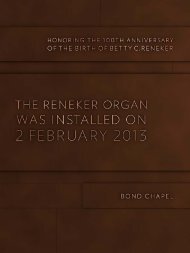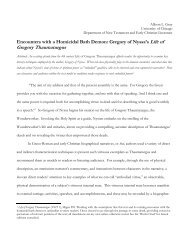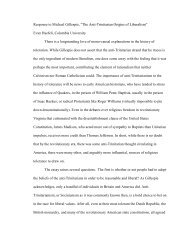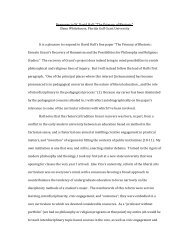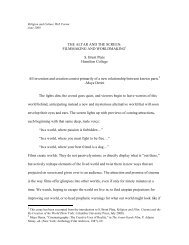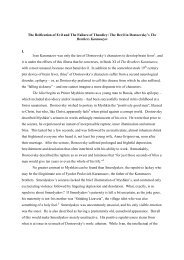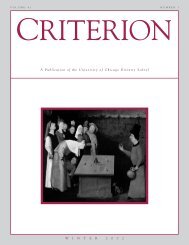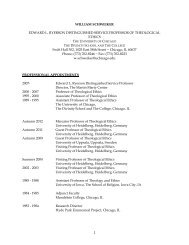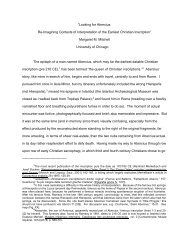Housing the Dead: the tomb as house in Roman Italy - Divinity School
Housing the Dead: the tomb as house in Roman Italy - Divinity School
Housing the Dead: the tomb as house in Roman Italy - Divinity School
You also want an ePaper? Increase the reach of your titles
YUMPU automatically turns print PDFs into web optimized ePapers that Google loves.
2<br />
<strong>the</strong> <strong>tomb</strong> of Naevoleia Tyche and Munatius Faustus, Augustalis and paganus, honoured by <strong>the</strong><br />
Council with a bisellium (Fig.1), seems to fit Trimalchio’s prescription,<br />
be sure to have ships <strong>in</strong> full sail on <strong>the</strong> … of my monument, and me sitt<strong>in</strong>g on a platform <strong>in</strong><br />
full official dress with five gold r<strong>in</strong>gs dish<strong>in</strong>g out c<strong>as</strong>h to <strong>the</strong> people from a bag…<br />
(for <strong>the</strong> parallel, see Kockel 1983, 105f.). Aga<strong>in</strong>, what makes <strong>the</strong> <strong>tomb</strong> a <strong>house</strong> is not so much shape<br />
<strong>as</strong> <strong>the</strong> extension of <strong>the</strong> activities of lifetime, <strong>the</strong> commercial success, <strong>the</strong> popular benefactions, and<br />
<strong>the</strong> garden which ensured that <strong>the</strong> family could have regular festivals to celebrate around <strong>the</strong> <strong>tomb</strong>,<br />
<strong>the</strong> Parentalia, <strong>the</strong> Rosalia and Violaria that are specified <strong>in</strong> so many <strong>in</strong>scriptions. People, not walls,<br />
make a <strong>house</strong> <strong>as</strong> well <strong>as</strong> a city.<br />
The <strong>tomb</strong>-<strong>as</strong>-<strong>house</strong> metaphor cont<strong>in</strong>ued to flourish throughout <strong>the</strong> empire, <strong>as</strong> <strong>the</strong> numerous<br />
p<strong>as</strong>sages cited by <strong>the</strong> Thesaurus L<strong>in</strong>guae Lat<strong>in</strong>ae show (TLL IV, 1979 sv domus 1B2c), and <strong>in</strong>to<br />
late antiquity. The Codex Theodosianus shows <strong>the</strong> deep concerns about <strong>the</strong> destruction of <strong>tomb</strong>s of<br />
<strong>the</strong> successors of Constant<strong>in</strong>e (who of course destroyed <strong>tomb</strong>s to build his b<strong>as</strong>ilica for St Peter), and<br />
<strong>the</strong> language of <strong>house</strong>s strangely <strong>in</strong>terweaves <strong>the</strong>ir protests. So Constantius II, from Milan <strong>in</strong> 356 or<br />
357:<br />
Those who violate <strong>the</strong> habitations of <strong>the</strong> shades, <strong>the</strong> homes, so to speak, of <strong>the</strong> dead, appear<br />
to perpetrate a two-fold crime. For <strong>the</strong>y both despoil <strong>the</strong> buried dead by <strong>the</strong> destruction of<br />
<strong>the</strong>ir <strong>tomb</strong>s, and <strong>the</strong>y contam<strong>in</strong>ate <strong>the</strong> liv<strong>in</strong>g by <strong>the</strong> use of this material <strong>in</strong> liv<strong>in</strong>g. (CT 9.17.4)<br />
So not only are <strong>tomb</strong>s like homes; <strong>the</strong>y specifically risk contam<strong>in</strong>ation by confusion with <strong>the</strong> homes<br />
of <strong>the</strong> liv<strong>in</strong>g.<br />
We learn that some men too eager for ga<strong>in</strong> destroy <strong>tomb</strong>s, and transfer <strong>the</strong> build<strong>in</strong>g material<br />
to <strong>the</strong>ir own homes (CT 9.17.3, Constantius, 356).<br />
The trouble of course is that <strong>tomb</strong>s are so close to <strong>house</strong>s that <strong>the</strong> elements are <strong>in</strong> part<br />
<strong>in</strong>terchangeable, a po<strong>in</strong>t re<strong>in</strong>forced by Julian:<br />
Some men even take away from <strong>the</strong> <strong>tomb</strong>s ornaments for <strong>the</strong>ir d<strong>in</strong><strong>in</strong>g rooms and porticoes<br />
(CT 9.17.5).<br />
The very fact that <strong>tomb</strong>s were places for d<strong>in</strong><strong>in</strong>g rendered <strong>the</strong>m <strong>the</strong> more suitable for despoliation for<br />
<strong>the</strong> benefit of <strong>the</strong> <strong>house</strong>s of <strong>the</strong> liv<strong>in</strong>g.<br />
Funerary epigraphy itself bears out <strong>the</strong> persistence <strong>in</strong> Lat<strong>in</strong> epitaphs of <strong>the</strong> <strong>house</strong>/<strong>tomb</strong> analogy.<br />
Richmond Lattimore (1962, 165ff) ga<strong>the</strong>red a selection of <strong>the</strong> p<strong>as</strong>sages, not<strong>in</strong>g <strong>the</strong> frequency of <strong>the</strong><br />
expression aeterna domus. The expression is ambiguous s<strong>in</strong>ce sometimes it refers to <strong>the</strong> Greek<br />
concept of Hades <strong>as</strong> <strong>the</strong> eternal <strong>house</strong> of <strong>the</strong> dead, but often too <strong>the</strong> reference to <strong>the</strong> <strong>tomb</strong> is explicit:



